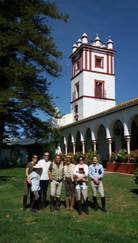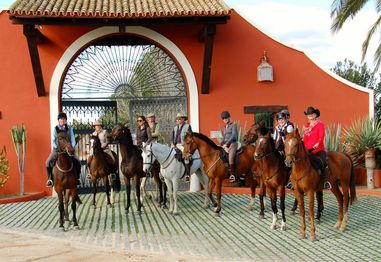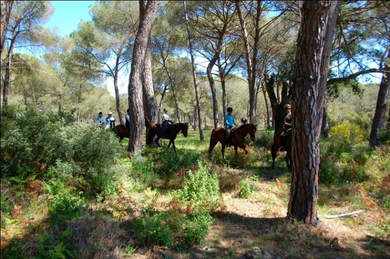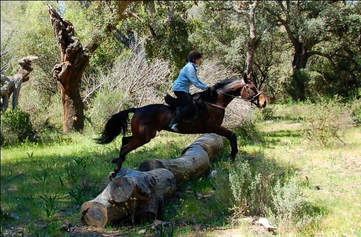DOÑANA PARK AND ATLANTIC COAST RIDE
(7 NIGHTS – 6 DAYS RIDING)

DAY 1
After a chance for guests to settle in they visit the stables where the horses have been prepared. We take great care that each rider has a horse suitable for his/her needs and riding experience. After trying the horses in the open air arena, guests go for a short hack through the countryside. Afterwards there is time to have a gin and tonic or two before having dinner at the finca.
You will be met at a central pick-up point (usually the Santa Justa Train Station in Seville or the airport) and transferred to Alfonso´s home. Guests will stay in a series of charming rooms with en-suite bathrooms and terraces, built close to the main house.

DAY 2
After breakfast guests will spend the day getting used to the horses. Today’s ride is through the farmland and countryside surrounding.
Alfonso´s home. The countryside is a mixture of olive groves, orange trees, open fields and pines with many sandy tracks that are great for cantering along. The ride passes several traditional Spanish cortijos and haciendas.
Every day throughout this ride guests will enjoy the Spanish tradition of an aperitif. This is a stop in an idylic spot where guests can stretch their legs and enjoy some Spanish cheese, chorizo and cold cuts of meat as well as a glass of sherry or cold beer.
The ride then continues on to the lunch stop which today is served in the shade of a pine copse. The horses are tethered nearby and have a chance to relax as guests enjoy a hot lunch with plenty of wine and refreshments before heading back to Alfonso´s . Dinner and drinks at Alfonso´s.

DAY 3.
After breakfast guests are transferred to Hacienda Torrequemada, a beautiful, large olive esate dating from the 17th Century which belongs to Alfonso´s family. It was once the monestary of San Ignacio de La Torrequemada and was built by monks returning from the New World. The horses are transferred here by lorry early in the morning and are waiting, tacked up and ready for their riders.
After breakfast guests are transferred to Hacienda Torrequemada, a beautiful, large olive esate dating from the 17th Century which belongs to Alfonso´s family. It was once the monestary of San Ignacio de La Torrequemada and was built by monks returning from the New World. The horses are transferred here by lorry early in the morning and are waiting, tacked up and ready for their riders.
Setting off from Torrequemada, the ride passes through miles of olive groves and open countryside heading towards the borders of the Doñana park. The aperitif today is served after an hour or so of riding at a nearby finca on the edges of the park and the ride then makes its way to a beautiful dehesa where lunch is served.
|
After lunch the ride crosses the River Quema (where the El Rocio pilgrims are baptised) and heads towards pine and oak forests.
|
DAY 4
After breakfast the riders rejoin the horses and then ride along the pilgrim trail of Pilas through forests of Holm and Cork Oaks and after the aperitif the ride follows the trail of Hinojos where lunch is served by the Pines.
In the late afternoon the ride arrives at a private finca called El Ranchito where the horses spend the night and guests are transferred the last kilometre to a charming hotel in El Rocio. Dinner is in El Rocio this evening.
DAY 5
Guests are transferred back to El Ranchito and ride out from here stopping in an area of the park called El Ajoli for the aperitif. The ride then makes its way into El Rocio itself, cantering into the village. Lunch is at a local restaurant where the horses are tied up to the hitching posts surrounding it.
Their is the chance afterwards to do some shopping before riding back to El Ranchito where the horses spend another night. Dinner in El Rocio and a second night´s stay in hotel.
DAY 6
Today the ride follows the pilgrim trail called Camino de Moguer, following La Rocina, a stream that feeds much of the marshland at the heart of the Doñana.
There are many fallow deer, red deer and wild boar in this region as well as a good selection of birds. After the aperitif stop the ride makes its way to the Lagoon of Ribatehilos where lunch is served.
|
Cabezudos was populated until the 1980s and at one stage even had its own casino. Each passing year brings more decay to the empty, ghost-like buildings and it is a rather eerie place. The horses spend the night here and the riders are transferred to the Parador of Mazagon where they have dinner and spend the night.
|
DAY 7
Today the ride reaches the Atlantic ocean, heading towards the Western tip of the Doñana park.
This is a very beautiful part of the Doñana, a mixture of lagoons, forests, wild shrubs and herbs such as rosemary and thyme, as well as plenty of mastic bushes where lynx can hide in wait for rabbits. It is all very unspoilt and isolated.
DAY 8
Breakfast and transfer to Seville, either to the airport or the Santa Justa train station.

History and Nature
About Sevilla
Sevilla is the capital of Andalusia and of the province of Seville. It is situated on the plain of the River Guadalquivir, with an average elevation of 7 metres (23 ft) above sea level. The inhabitants of the city are known as sevillanos or hispalenses, following the Roman name of the city, Hispalis.
Sevilla is without a doubt one of Spain’s most beautiful cities. The Sevillanos are an extremely proud and passionate people. To many Sevilla is not just a place, it is a way of life. The Guadalquivir, Semana Santa, the April Feria, Velazquez, Don Juan Tenorio, orange blossom, the dancing of Sevillanas and bullfights….. Sevilla is bright, beautiful and a city that must be seen and must be experienced.
Following the Moorish conquest in 712, Seville came under a long period of Moorish rule. It was during this period that both the Giralda and the Mosque (Mezquita) were built, on the site where the Cathedral now stands.
With the discovery of America in 1492, Sevilla developed a monopoly on trade with the New World. It became the arrival and departure point for every expedition to the newly discovered continent. Sevilla began to amass a great wealth, palaces were built, new industries were created and the whole city was a hive of activity. All financed by American gold.
In 1929 Sevilla hosted the Ibero-American Exhibition and in 1992, the Expo. Both of these events had a significant impact on Sevilla to become the beautiful city you can discover nowadays.
More information at
www.visitasevilla.es

Coto Doñana
Nacional Park
The Parque Nacional de Doñana is one of Europe's most important wetland reserves and a major site for migrating birds. It is an immense area; the parque itself and surrounding parque natural or Entorno de Doñana (a protected buffer zone) amount to over 1,300 sq km in the provinces of Huelva, Sevilla and Cádiz. It is internationally for recognised for its great ecological wealth. Doñana has become a key centre in the world of conservationism.
Doñana is well known for its enormous variety of bird species, either permanent residents, winter visitors from north and central Europe or summer visitors from Africa, like its numerous types of geese and colourful colonies of flamingo. It has one of the world's largest colonies of Spanish imperial eagles. The park as a whole comprises three distinct kinds of ecosystem: the marismas, the Mediterranean scrublands and the coastal mobile dunes with their beaches.
The configuration of the Parque Nacional de Doñana is a result of its past as the delta of the Guadalquivir river, the 'big river', or Wada-I-Kebir, of the Moors. But it is a delta with a difference. Unlike most, the river has only one outlet to the sea, just below Sanlúcar de Barrameda. The rest of what used to be its delta has gradually been blocked off by a huge sandbar that stretches from the mouth of the Río Tinto, near Palos de la Frontera, to the riverbank opposite Sanlúcar, and which the sea winds have gradually formed into high dunes. Behind this natural barrier stretches the marshlands (marismas).
The effect of this extraordinary mélange of land and water was to create an environment shunned by people but ideal for wildlife. As early as the thirteenth century, the kings of Castille set aside a portion of the Doñana as a royal hunting estate; later the dukes of Medina Sidonia made it their private coto too. One of the duchesses of Medina Sidonia, Doná Ana de Silva y Mendoza, indulged her antisocial instincts by building a residence there that was more hermitage than palace. As a result, the entire region came to be known as the 'forest of Doná Ana', or Doñana. In the eighteenth century, Goya is known to have visited the Duchess of Alba at the Palacio de Doñana when she was its proprietress. Subsequently, the land passed through many hands before the official creation of the parque nacional in 1969.
Doñana National Park is a wetland / coastal reserve at the delta of the Guadalquivir River and a major site for migrating birds. The park holds 360 species of birds, in transfer from or to Africa (on the same flyway as Djoudj and Banc d’Arguin). Especially noted are its wintering waterfowl, which number over 500.000.
The importance of the Doñana region cannot be overstressed. Half a million wintering birds, mainly wildfowl and waders, flock to the area each year to escape the much colder weather conditions in the north of Europe and many more use it as a feeding station during the migration periods in spring and autumn. It is also of major importance as a breeding ground for some of the scarcest and most endangered bird species in Europe, such as the Spanish Imperial Eagle, the Marbled Duck and the Red-knobbed Coot. The park also is the habitat of the endangered Spanish lynx, Adalbert’s eagle, marbled teal and white-headed duck.
The Parque Nacional de Doñana is one of Europe's most important wetland reserves and a major site for migrating birds. It is an immense area; the parque itself and surrounding parque natural or Entorno de Doñana (a protected buffer zone) amount to over 1,300 sq km in the provinces of Huelva, Sevilla and Cádiz. It is internationally for recognised for its great ecological wealth. Doñana has become a key centre in the world of conservationism.
Doñana is well known for its enormous variety of bird species, either permanent residents, winter visitors from north and central Europe or summer visitors from Africa, like its numerous types of geese and colourful colonies of flamingo. It has one of the world's largest colonies of Spanish imperial eagles. The park as a whole comprises three distinct kinds of ecosystem: the marismas, the Mediterranean scrublands and the coastal mobile dunes with their beaches.
The configuration of the Parque Nacional de Doñana is a result of its past as the delta of the Guadalquivir river, the 'big river', or Wada-I-Kebir, of the Moors. But it is a delta with a difference. Unlike most, the river has only one outlet to the sea, just below Sanlúcar de Barrameda. The rest of what used to be its delta has gradually been blocked off by a huge sandbar that stretches from the mouth of the Río Tinto, near Palos de la Frontera, to the riverbank opposite Sanlúcar, and which the sea winds have gradually formed into high dunes. Behind this natural barrier stretches the marshlands (marismas).
The effect of this extraordinary mélange of land and water was to create an environment shunned by people but ideal for wildlife. As early as the thirteenth century, the kings of Castille set aside a portion of the Doñana as a royal hunting estate; later the dukes of Medina Sidonia made it their private coto too. One of the duchesses of Medina Sidonia, Doná Ana de Silva y Mendoza, indulged her antisocial instincts by building a residence there that was more hermitage than palace. As a result, the entire region came to be known as the 'forest of Doná Ana', or Doñana. In the eighteenth century, Goya is known to have visited the Duchess of Alba at the Palacio de Doñana when she was its proprietress. Subsequently, the land passed through many hands before the official creation of the parque nacional in 1969.
Doñana National Park is a wetland / coastal reserve at the delta of the Guadalquivir River and a major site for migrating birds. The park holds 360 species of birds, in transfer from or to Africa (on the same flyway as Djoudj and Banc d’Arguin). Especially noted are its wintering waterfowl, which number over 500.000.
The importance of the Doñana region cannot be overstressed. Half a million wintering birds, mainly wildfowl and waders, flock to the area each year to escape the much colder weather conditions in the north of Europe and many more use it as a feeding station during the migration periods in spring and autumn. It is also of major importance as a breeding ground for some of the scarcest and most endangered bird species in Europe, such as the Spanish Imperial Eagle, the Marbled Duck and the Red-knobbed Coot. The park also is the habitat of the endangered Spanish lynx, Adalbert’s eagle, marbled teal and white-headed duck.

















